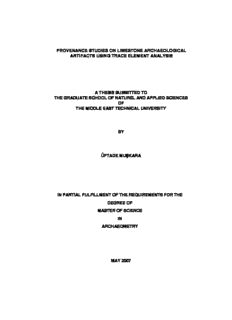Table Of ContentPROVENANCE STUDIES ON LIMESTONE ARCHAEOLOGICAL
ARTIFACTS USING TRACE ELEMENT ANALYSIS
A THESIS SUBMITTED TO
THE GRADUATE SCHOOL OF NATUREL AND APPLIED SCIENCES
OF
THE MIDDLE EAST TECHNICAL UNIVERSITY
BY
ÜFTADE MUŞKARA
IN PARTIAL FULFILLMENT OF THE REQUIREMENTS FOR THE
DEGREE OF
MASTER OF SCIENCE
IN
ARCHAEOMETRY
MAY 2007
Approval of the Graduate School of Natural and Applied Sciences.
____________________
Prof. Dr. Canan ÖZGEN
Director
I certify that this thesis satisfies all the requirements as a thesis for the degree of
Master of Science.
_____________________
Prof. Dr. Asuman G. TÜRKMENOĞLU
Head of Department
This is to certify that we have read this thesis and that in our opinion it is fully
adequate, in scope and quality, as a thesis for the degree of Master of Science.
_______________________ _______________________
Prof.Dr. Şahinde DEMİRCİ Prof. Dr. O. Yavuz ATAMAN
Co-Supervisor Supervisor
Examining Committee Members
Prof. Dr. Asuman G. TÜRKMENOĞLU (METU, GEOE) _____________________
Prof. Dr. O. Yavuz ATAMAN (METU, CHEM) _____________________
Prof. Dr. Şahinde DEMİRCİ (METU, CHEM) _____________________
Prof. Dr. Numan TUNA (METU, City Planning) _____________________
Prof. Dr. Mürvet VOLKAN (METU, CHEM) _____________________
I hereby declare that all information in this document has been obtained
and presented in accordance with academic rules and ethical conduct. I
also declare that, as required by these rules and conduct, I have fully cited
and referenced all material and results that are not original to this work.
Name, Last name :
Signature :
iii
ABSTRACT
PROVENANCE STUDIES ON LIMESTONE ARCHAEOLOGICAL
ARTIFACTS USING TRACE ELEMENT ANALYSIS
Muşkara, Üftade
M.S., Department of Archaeometry
Supervisor : Prof. Dr. O. Yavuz Ataman
Co-Supervisor : Prof.Dr. Şahinde Demirci
May 2007, 61 pages
Trace element composition of archaeological artifacts is commonly used for
provenance studies. Limestone has generally studied by geologists and there are
a few researches done by various archaeological sciences. Although it is a
common material for buildings and sculpture it is been thought that limestone
used had not imported like marbles.
Limestone figurines from Datça/Emecik excavations are classified as Cypriote
type, which was very popular through 6th century B.C. in the Mediterranean
region. Since this type of figurines was found at Emecik numerously to determine
its provenance was an important problem.
Emecik figurines were examined for their some major, trace elements and REE
compositions and results were compared with geological samples which were
iv
taken from a near by quarry. Inductively Coupled Plasma-Optical Emission
Spectrometry (ICP-OES), Inductively Coupled Plasma-Mass Spectrometry (ICP-
MS) have been used for analysis. The methods have been optimized by using
standard reference material NIST 1d, NCS DC 73306, and IGS40.
Keywords: inductively coupled plasma – mass spectrometry, limestone,
provenance, Cypriot figurines, REE.
v
ÖZ
ESER ELEMENT ANALİZİ İLE ARKEOLOJİK KİREÇTAŞI
BULUNTULARIN HAMMADDE KAYNAĞININ SAPTANMASI
ÇALIŞMALARI
Muşkara, Üftade
Yüksek Lisans, Arkeometri ABD
Tez Yöneticisi : Prof. Dr. O. Yavuz Ataman
Ortak Tez Yöneticisi : Prof.Dr. Şahinde Demirci
Mayıs 2007, 61 sayfa
Arkeolojik buluntuların eser element bileşimi, hammadde kaynağının
belirlenmesine yönelik araştırmalarda sıklıkla kullanılmaktadır. Kireçtaşı genel
olarak jeologlarca çalışılmış, ancak arkeolojik bilimlerin konusunu oluşturan sayılı
inceleme bulunmaktadır. Yapı ve heykel malzemesi olarak yaygın kullanılmasına
karşın mermerden farklı değerlendirilmiş ve ithalatının yapılmadığı
düşünülmüştür.
Datça/Emecik arkeolojik kazılarında bulunan kireçtaşı figürinler M.Ö. 6. yy.
Boyunca Akdeniz havzasında yaygın olan Kıbrıs tipi olarak tanımlanmıştır.
Emecik’te bu tip figürinler çok sayıda ele geçtiğinde ham madde kaynağının
belirlenmesi önemli bir problemdir.
vi
Emecik figürinleri bazı major, eser elementler ve nadir toprak elementleri
derişimleri açısından incelenmiş ve sonuçlar Emecik civarındaki bir taş
ocağından alınan örneklerin bileşimi ile karşılaştırılmıştır. Analizlerde indüktif
eşleşmiş plazma - optik emisyon spektrometrisi (ICP-OES) ve indüktif eşleşmiş
plazma - kütle spektrometrisi (ICP-OES). Kullanılan yöntemin etkinliği ve
dopruluğu standart referans madde ile kontrol edildi.
Anahtar Kelimeler: indüktif eşli plazma – kütle spektrometrisi, kireçtaşı,
hammadde kaynağı, Kıbrıs figürinleri, nadir toprak elementleri.
vii
To the memory of Savaş…
viii
AKNOWLEDGEMENT
I would like to express my deep appreciation to my supervisor Prof. Dr. O. Yavuz
Ataman especially for his encouragement to study with his group in Chemistry
Department, METU and for his guidance, understanding and friendship
throughout this study. I am deeply grateful to Prof. Dr. Şahinde Demirci for her
encouragement and contribution during the study.
I thank to Prof. Dr. Numan Tuna for offering me the subject of the study, selecting
the figurine samples, suggesting the quarry and his guidance; to İlham Sakarya
and Nadire Atıcı for their help for sampling. I thank to Assist. Prof. Dr. Uwe
Müller, Prof. Dr. Elvan Yılmaz, Assist. Prof. Dr. Osman Yılmaz, Bülent
Kızılduman, Eastern Mediterranean University for providing the geological
samples from Cyprus. I would like to thank Prof. Dr. İbrahim Gündiler, New
Mexico Bureau of Mines for providing the standard reference material NCS DC
73306.
I would like to thank for Prof. Dr. Asuman G. Türkmenoğlu for thin-section and
XRD analyses of samples and for her guidance.
My special thanks to Sezgin Bakırdere for his endless assistance during my work
especially regarding the instrumental analyses and for his invaluable support. I
would like to thank all my friends in Atomic and Molecular Analysis Research
Group for their friendship and kind support.
I also thank the examining committee members for their valuable contributions to
my thesis.
Finally, I am appreciated to my mother, father and sister for their love and logical
supports since the very beginning.
ix
TABLE OF CONTENTS
PLAGIARISM…………………………………………………………………………....iii
ABSTRACT………………………………………………………………………………iv
ÖZ………………………………………………………………………………………...vi
ACNOWLEDGEMENTS…………………………………………..…………………...ix
TABLE OF CONTENTS…………………………………………………………….…..x
LIST OF TABLES ….…………………………………………………………….…....xii
LIST OF FIGURES………………………………………………………………….…xiii
CHAPTERS
1. INTRODUCTION………………………………………………………….…….1
1.1. Limestone………………………………………………………….………..2
1.1.1. Diagenesis of Limestone…………………………………......3
1.1.2. Classification of Limestone…………………………………..4
1.1.3. Physical Properties of Limestone……………………………5
1.1.4. Chemical Properties of Limestone…………………………..7
1.2. Limestone Figurines………………………………………………………..7
1.2.1. Cypriot Type Figurines….…….………………………………8
1.2.2. Emecik Figurines…………………………………………….11
1.2.3. Datça/Emecik Sarı Liman Excavations……………………14
1.3. Provenance Studies of Limestone………………………………………15
1.4. Provenance Studies of Figurines……………………………………..…23
1.5. Aim of the Study…………………………………………………………..25
2. EXPERIMENTAL……….……………………………………………………..26
2.1. Chemical and Reagents..………………………………………………..26
2.1.1. Water and Acids……………………………………………..26
2.1.2. Standard Solutions…………………………………………..26
x
Description:Trace element composition of archaeological artifacts is commonly used for a few researches done by various archaeological sciences. Meantime, Y and Th showed a strong positive correlation and Rb, Ba, TiO2 show .. Milestone Ethos PLUS microwave dissolution system was used in the closed

